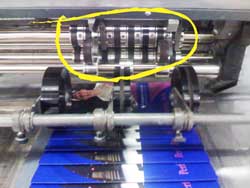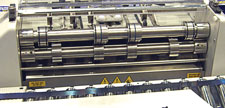Ever notice how the world of bindery work is full of paradox? Maybe you’ve felt the thumping of a sprawling, battleship-sized saddle stitcher shaking the foundations as it runs, but which requires the lightest of feather touches when loading 4 page signatures. Perhaps you’ve seen a huge armor plated tank of a guillotine cutter, slicing through 1,000 sheets of paper in a single heartbeat yet requiring the fingers of a magician to move the tiny cut labels off to the side table in neat piles for packing.
Glancing at a lot of bindery and printing equipment it’s easy to see why a ‘more is better’ state of mind can arise, especially for the newcomer. Some of this stuff is just…big. Yet with experience it’s not long before we find out just how much finesse is required. We discover our job is to coax a thin, lightweight, fragile, easy-to-tear and totally limp piece of paper from one end of an unyielding machine to the other. On the way we subject it to an assortment of folding, cutting, perfing, ink-jetting or gluing operations and then hope that it comes out in the perfectly printed and finished glory envisioned by some far-away designer.
So when we run across the “too much” problem in the bindery…too much pressure, too much speed, too much make ready time, we understand where the more-is-better attitude might have come from. They may not have learned enough from the bindery paradox—that sometimes the way to better control and more speed is through less.
 One practice we routinely see that falls in this category is the problem of too many pull out wheels (a.k.a. pull out tires, gripper rollers, transfer wheels) on the slitter shaft. (photo at left) In our experience with thousands of bindery customers who do precision scoring, perfing and cutting operations on their folders, the rule of thumb is that fewer pull out wheels will deliver better results. It’s important to keep them to an absolute minimum. (A side note: the photo is an exaggeration...or maybe not for some operators...but we use it to illustrate the point. This setup is actually a clever brochure flattening technique you can read about here.)
One practice we routinely see that falls in this category is the problem of too many pull out wheels (a.k.a. pull out tires, gripper rollers, transfer wheels) on the slitter shaft. (photo at left) In our experience with thousands of bindery customers who do precision scoring, perfing and cutting operations on their folders, the rule of thumb is that fewer pull out wheels will deliver better results. It’s important to keep them to an absolute minimum. (A side note: the photo is an exaggeration...or maybe not for some operators...but we use it to illustrate the point. This setup is actually a clever brochure flattening technique you can read about here.)
Here’s the scenario: a folder operator runs into a problem such as inconsistent score register, perf register, a crooked trim or lead edge nicking in the main, parallel section. The first reaction is frequently to add more pull out wheels. “Hey, it’s moving around. Let me add more wheels to stabilize it and give me more control.” In our experience, this either makes the problem worse or it masks the real cause of the problem. It rarely solves the original problem.
One of the reasons for this is that the outside diameters (OD) of the pull out wheels and various tools in use on the shaft are probably not all the same. The different OD’s mean each roller is trying to move the sheet at a slightly different speed. In many scoring and perf jobs we are trying to accomplish a very precise operation on a single sheet of paper. Thus, even very tiny variations in rotational speed are apt to cause an issue than they otherwise might on a multi-panel folded sheet.
 We have two suggestions regarding pull out wheels. First, you may want to try running the folder without any pull out wheels, or alternatively with wheels on the bottom shaft only to provide some support. Simply offset the upper and lower wheels as shown at right to test this. In many cases (but not all) the score or perf tools provide all the drive and support you need. This is especially true if for instance, you are using 2 or more Tri-Creasers to score a job.
We have two suggestions regarding pull out wheels. First, you may want to try running the folder without any pull out wheels, or alternatively with wheels on the bottom shaft only to provide some support. Simply offset the upper and lower wheels as shown at right to test this. In many cases (but not all) the score or perf tools provide all the drive and support you need. This is especially true if for instance, you are using 2 or more Tri-Creasers to score a job.
Removing the pull out wheels removes one variable from the mix; it’s one less thing to troubleshoot and one less thing to cause problems. In many cases this will get rid of lead-edge nicking when scoring or perfing. It also reduces the potential for marking on sensitive matte and dull coated stocks.
 Secondly, should you find you do indeed need the pull wheels, use the bare minimum. For instance, try one pair only on either side of the sheet (photo at left) and avoid loading up the shaft with extra wheels.
Secondly, should you find you do indeed need the pull wheels, use the bare minimum. For instance, try one pair only on either side of the sheet (photo at left) and avoid loading up the shaft with extra wheels.
We know someone’s going to tell us they use 18 sets of pull out wheels on every job and everything runs perfectly at maximum speed. That’s OK…We said it was a world of paradox and sometimes it seems the more we learn, the less we know. We can take it!
The bottom line is that minimizing the number of pull out wheels is a very simple tactic that only takes a minute, doesn’t require any skill and will likely improve quality and productivity on your folding machine (or scoring machine.) As always we welcome your comments below.

